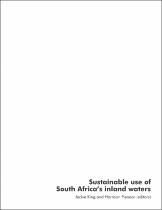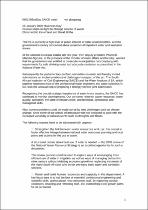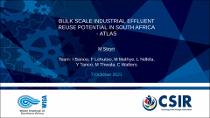 ResearchSpace
ResearchSpace
Sustainable Use of South Africa's Inland Waters: A situation assessment of Resource Directed Measures 12 years after the 1998 National Water Act
JavaScript is disabled for your browser. Some features of this site may not work without it.
- ResearchSpace
- →
- Research Publications/Outputs
- →
- Conference Publications
- →
- View Item
| dc.contributor.author |
King, J

|
|
| dc.contributor.author |
Pienaar, Harrison

|
|
| dc.date.accessioned | 2022-05-27T09:15:55Z | |
| dc.date.available | 2022-05-27T09:15:55Z | |
| dc.date.issued | 2011-09 | |
| dc.identifier.citation | King, J. & Pienaar, H. 2011. <i>Sustainable Use of South Africa's Inland Waters: A situation assessment of Resource Directed Measures 12 years after the 1998 National Water Act</i>. WRC. http://hdl.handle.net/10204/12429 . | en_ZA |
| dc.identifier.uri | http://hdl.handle.net/10204/12429 | |
| dc.description.abstract | Water resources provide important benefits to humankind in the form of commodities such as water and food and by enhancing lives in many other ways. In South Africa, a water-scarce country, we recognise that water resources are under stress as never before, as competition for water increases between potential or actual users from a range of sectors. All these sectors contribute to the welfare of the country, including poverty eradication, through improved economic development and the creation of employment. Water is also fundamental for the long-term sustainability of our water resources as functioning ecosystems but only if they are in good ecological condition can they continue to provide the ecological services we value. Over the last two decades, the Water Research Commission has helped to stimulate the research-based development of a ground-breaking policy that recognises water resources as living aquatic ecosystems and sets out an approach for South Africa that supports their sustainable use and management. Guided by the Agenda 21 global initiative, this approach is encapsulated in Chapter 3 of the country’s National Water Act, Act 36 of 1998 (NWA). The NWA recognises three Resource Directed Measures: the Classification System, the Reserve, and Resource Quality Objectives, which together form the protection measures for the country’s water resources. Since the promulgation of the NWA, the move to implement Resource Directed Measures has made considerable progress in South Africa, in parallel with new and visionary technologies that are helping to operationalise these protection measures in harmony with the imperative for water-resource development. There has been constructive engagement between sectors throughout, particularly between water scientists, research institutes and government. Collaboration such as this is possibly unrivalled in the world, even if the road has been rocky at times. While the NWA, with its measures for protecting water resources is visionary and innovative, its implementation will be neither quick nor easy – worthwhile endeavours such as this seldom are. As a community of water specialists, we have spent the last 20 years developing methods and tools to assess the Reserve – that is, learning how to assess the water needed for basic human needs and for sustaining the ecological health of the aquatic systems. We have created awareness of why this water is necessary for maintaining ecosystem health, done the research, tested the outputs and put the organisational structures in place to make protection measures effective. In the last few years, work on the other two Resource Directed Measures has also begun. In essence, what comes next is a bigger challenge than all that has gone before – making our new water vision work on the ground and giving effect to all three Resource Directed Measures. This will require greater integration and cooperation than has happened so far, both within the Department of Water Affairs as well as within and between other organisations, stakeholders and society at large. We must also continue to invest in research that allows us to better understand our water resources and predict how human activities can impact them, as this will enhance our ability to make informed and accountable decisions on water use. South Africa is a world leader in this field and aims to continue to claim its space in the global knowledge economy. Whatever course we follow into the future involves compromise – we may gain benefits with development, but we may incur costs in terms of declining ecosystem health and the loss of ecological services. We need to work together as a country to identify catchment by catchment what these benefits and costs would be and to ascertain the point of acceptable trade-off between water resource development on the one hand and aquatic ecosystem protection on the other. We then need to learn to live within the boundaries we have recognised. That is truly sustainable use of water and the three Resource Directed Measures are designed to help us achieve this. | en_US |
| dc.format | Fulltext | en_US |
| dc.language.iso | en | en_US |
| dc.publisher | WRC | en_US |
| dc.relation.uri | http://www.wrc.org.za/wp-content/uploads/mdocs/TT%20491-11.pdf | en_US |
| dc.subject | South African water supply | en_US |
| dc.subject | South African water demand | en_US |
| dc.subject | Biodiversity | en_US |
| dc.subject | Ecosystem | en_US |
| dc.subject | South Africa's Inland Waters | en_US |
| dc.title | Sustainable Use of South Africa's Inland Waters: A situation assessment of Resource Directed Measures 12 years after the 1998 National Water Act | en_US |
| dc.type | Report | en_US |
| dc.description.pages | 262 | en_US |
| dc.description.reportnumber | WRC Report Number TT 491/11 | en_US |
| dc.description.cluster | Natural Resources and the Environment | en_US |
| dc.description.cluster | Smart Places | en_US |
| dc.identifier.apacitation | King, J., & Pienaar, H. (2011). <i>Sustainable Use of South Africa's Inland Waters: A situation assessment of Resource Directed Measures 12 years after the 1998 National Water Act</i> WRC. Retrieved from http://hdl.handle.net/10204/12429 | en_ZA |
| dc.identifier.chicagocitation | King, J, and Harrison Pienaar <i>Sustainable Use of South Africa's Inland Waters: A situation assessment of Resource Directed Measures 12 years after the 1998 National Water Act.</i> WRC, 2011. http://hdl.handle.net/10204/12429 | en_ZA |
| dc.identifier.vancouvercitation | King J, Pienaar H. Sustainable Use of South Africa's Inland Waters: A situation assessment of Resource Directed Measures 12 years after the 1998 National Water Act. 2011 [cited yyyy month dd]. Available from: http://hdl.handle.net/10204/12429 | en_ZA |
| dc.identifier.ris | TY - Report AU - King, J AU - Pienaar, Harrison AB - Water resources provide important benefits to humankind in the form of commodities such as water and food and by enhancing lives in many other ways. In South Africa, a water-scarce country, we recognise that water resources are under stress as never before, as competition for water increases between potential or actual users from a range of sectors. All these sectors contribute to the welfare of the country, including poverty eradication, through improved economic development and the creation of employment. Water is also fundamental for the long-term sustainability of our water resources as functioning ecosystems but only if they are in good ecological condition can they continue to provide the ecological services we value. Over the last two decades, the Water Research Commission has helped to stimulate the research-based development of a ground-breaking policy that recognises water resources as living aquatic ecosystems and sets out an approach for South Africa that supports their sustainable use and management. Guided by the Agenda 21 global initiative, this approach is encapsulated in Chapter 3 of the country’s National Water Act, Act 36 of 1998 (NWA). The NWA recognises three Resource Directed Measures: the Classification System, the Reserve, and Resource Quality Objectives, which together form the protection measures for the country’s water resources. Since the promulgation of the NWA, the move to implement Resource Directed Measures has made considerable progress in South Africa, in parallel with new and visionary technologies that are helping to operationalise these protection measures in harmony with the imperative for water-resource development. There has been constructive engagement between sectors throughout, particularly between water scientists, research institutes and government. Collaboration such as this is possibly unrivalled in the world, even if the road has been rocky at times. While the NWA, with its measures for protecting water resources is visionary and innovative, its implementation will be neither quick nor easy – worthwhile endeavours such as this seldom are. As a community of water specialists, we have spent the last 20 years developing methods and tools to assess the Reserve – that is, learning how to assess the water needed for basic human needs and for sustaining the ecological health of the aquatic systems. We have created awareness of why this water is necessary for maintaining ecosystem health, done the research, tested the outputs and put the organisational structures in place to make protection measures effective. In the last few years, work on the other two Resource Directed Measures has also begun. In essence, what comes next is a bigger challenge than all that has gone before – making our new water vision work on the ground and giving effect to all three Resource Directed Measures. This will require greater integration and cooperation than has happened so far, both within the Department of Water Affairs as well as within and between other organisations, stakeholders and society at large. We must also continue to invest in research that allows us to better understand our water resources and predict how human activities can impact them, as this will enhance our ability to make informed and accountable decisions on water use. South Africa is a world leader in this field and aims to continue to claim its space in the global knowledge economy. Whatever course we follow into the future involves compromise – we may gain benefits with development, but we may incur costs in terms of declining ecosystem health and the loss of ecological services. We need to work together as a country to identify catchment by catchment what these benefits and costs would be and to ascertain the point of acceptable trade-off between water resource development on the one hand and aquatic ecosystem protection on the other. We then need to learn to live within the boundaries we have recognised. That is truly sustainable use of water and the three Resource Directed Measures are designed to help us achieve this. DA - 2011-09 DB - ResearchSpace DP - CSIR KW - South African water supply KW - South African water demand KW - Biodiversity KW - Ecosystem KW - South Africa's Inland Waters LK - https://researchspace.csir.co.za PY - 2011 T1 - Sustainable Use of South Africa's Inland Waters: A situation assessment of Resource Directed Measures 12 years after the 1998 National Water Act TI - Sustainable Use of South Africa's Inland Waters: A situation assessment of Resource Directed Measures 12 years after the 1998 National Water Act UR - http://hdl.handle.net/10204/12429 ER - | en_ZA |
| dc.identifier.worklist | 9314 | en_US |
| dc.identifier.worklist | 25344 | en_US |








